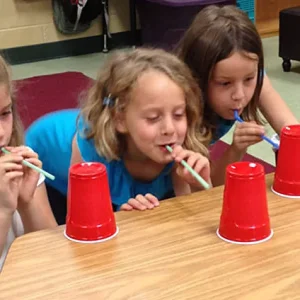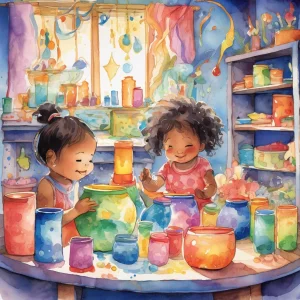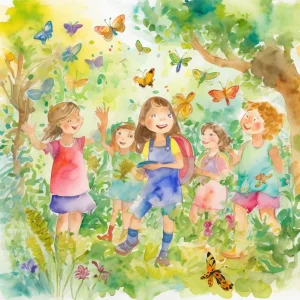Activity
Similar Activities
Whimsical Cup Blow Race for Kids
Children’s Age: 4–6 years
Activity Duration: 5 – 10 minutes
The Cup Race Challenge activity is designed to boost teamwork, fine motor skills, and problem-solving in children. You'll need plastic cups, straws, a table, and masking tape to cr…
Activity Duration: 5 – 10 minutes
Whispers of Imagination: A Tale Unfolds
Children’s Age: 2–2.5 years
Activity Duration: 15 minutes
Join "Story Collage Time" for children aged 24 to 30 months, a creative activity fostering language development, play skills, and imagination. Gather child-friendly scissors, glue …
Activity Duration: 15 minutes
Enchanted Musical Storytime Adventure: A Journey Through Sound
Children’s Age: 2–3 years
Activity Duration: 10 minutes
"Musical Storytime Adventure" is a delightful activity designed for children aged 24 to 36 months to enjoy a fun and educational experience. Set up by gathering picture books and c…
Activity Duration: 10 minutes
Colorful Sorting Fun: Exploring Colors and Shapes
Children’s Age: 1.5–2 years
Activity Duration: 5 – 10 minutes
"Colorful Sorting Fun" is an engaging activity designed for children aged 18 to 24 months to boost their fine motor skills, cognitive abilities, and color recognition. Prepare colo…
Activity Duration: 5 – 10 minutes
Cultural Collage Fun: Exploring Diversity Through Art
Children’s Age: 2–3 years
Activity Duration: 15 minutes
"Cultural Collage Fun" is a creative activity designed for children aged 24 to 36 months to develop play skills, cultural awareness, and communication abilities. With magazines, ch…
Activity Duration: 15 minutes
Enchanted Nature Scavenger Hunt with Family and Friends
Children’s Age: 6–10 years
Activity Duration: 15 – 30 minutes
Explore the "Family and Friends Nature Scavenger Hunt," a fun-filled activity tailored for children aged 6 to 10. This engaging hunt fosters observation skills, teamwork, and envir…
Activity Duration: 15 – 30 minutes
Enchanted Nature Discovery: Sensory Nature Exploration
Children’s Age: 1.5–2 years
Activity Duration: 10 – 15 minutes
Engage your 12 to 18-month-old in the Sensory Nature Exploration activity, fostering their sensory development through natural exploration. Set up a sensory bin with sand or water,…
Activity Duration: 10 – 15 minutes
Ecosystem Adventure Board Game - Nature's Quest
Children’s Age: 7–9 years
Activity Duration: 10 – 25 minutes
An interactive board game where children explore and learn about ecosystems through challenges and tasks.
Activity Duration: 10 – 25 minutes
Musical Painting Fun: Expressive Art and Melodies
Children’s Age: 2–3 years
Activity Duration: 10 – 30 minutes
This activity involves children creating paintings while listening to music that matches the mood of sentences they choose. It helps with sensory development, and social-emotional …
Activity Duration: 10 – 30 minutes
Musical Kindness Quilt
Children’s Age: 8–10 years
Activity Duration: 10 – 20 minutes
The "Musical Kindness Quilt" activity engages 9-year-old children in learning about famous musicians while enhancing communication skills and cognitive development. Children choo…
Activity Duration: 10 – 20 minutes
Whispers of Nature Rhythms: Exploring Beats and Patterns
Children’s Age: 3–7 years
Activity Duration: 10 – 30 minutes
Let's explore "Nature Rhythms" together! We will listen to nature's beats and patterns using rocks, sticks, leaves, and pinecones. Find a safe outdoor spot, gather natural material…
Activity Duration: 10 – 30 minutes
Enchanted Nature-Based Storytelling Adventure
Children’s Age: 0 month – 6 years
Activity Duration: 5 – 10 minutes
Let's have fun with Nature-Based Storytelling! Find a cozy outdoor spot, lay down a blanket, and bring a basket for collecting leaves and stones. Sit with your child, explore natur…
Activity Duration: 5 – 10 minutes


























